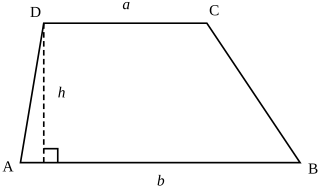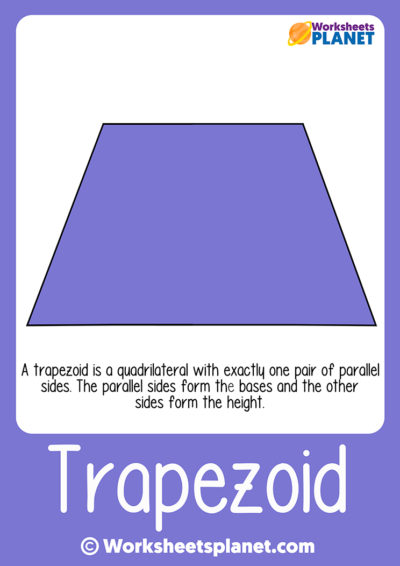
The missing side of the trapezoid can be determined from the information given to you. How do you Find the Missing Side of a Trapezoid? Opposite sides of an isosceles trapezoid are congruent.The intersection point of the diagonals is collinear (in the same line) to the midpoints of the two opposite sides.
 Its base angles and diagonals are equal if the trapezoid is isosceles. The three main attributes of a trapezoid are as follows What are the Three Attributes of a Trapezoid? It has two sides that are parallel, and two sides that aren’t. Since the trapezoid has four sides, it automatically becomes a quadrilateral. The area of a trapezoid = x h, where a and b are the lengths of the bases and h represents the height. The perimeter of a trapezoid PQRS is given as, Perimeter = PQ + QR + RS + PS. One equation calculates its area the other is its perimeter. The area of a trapezoid is calculated by calculating the average of the two parallel sides and multiplying it by its height.Īrea = × h, where a and b are the lengths of the bases and h represents the height. Angles next to each other sum up to 180°. An isosceles trapezoid consists of equal lengths of opposite sides. The top and the bottom bases of a trapezoid are parallel. There are many properties of a trapezoid few of them are listed below: What are the Basic Properties of Trapezoid? The main types of trapezoids are listed below: The trapezoids are classified on the basis of the nature of their sides. The shortest distance between two parallel sides is known as the altitude. The non-parallel sides are known as the legs or lateral sides of a trapezoid. The sides of a trapezoid are parallel to each other and they are termed as the bases of the trapezoid. Listed below are a few topics that are related to a trapezoid.Ī trapezoid is a four-sided closed 2D shape that has an area and a perimeter. Where, a, b,c, and d are the sides of the trapezoid. Perimeter of a Trapezoid = Sum of all the sides = a + b + c + d The perimeter of the trapezoid formula is calculated by finding the sum of all the sides i.e, AB + BC + CD + DA Consider a trapezoid ABCD as shown below with side measures a,b,c, and d. Since the trapezoid is a two-dimensional shape, thus, the perimeter will also lie in a two-dimensional plane only. The perimeter of a trapezoid is defined as the total length of the boundary of the shape, i.e. Hence, the area of a trapezoid is calculated by the following formula: a and b and whose height is h which is the perpendicular distance between a and b.
Its base angles and diagonals are equal if the trapezoid is isosceles. The three main attributes of a trapezoid are as follows What are the Three Attributes of a Trapezoid? It has two sides that are parallel, and two sides that aren’t. Since the trapezoid has four sides, it automatically becomes a quadrilateral. The area of a trapezoid = x h, where a and b are the lengths of the bases and h represents the height. The perimeter of a trapezoid PQRS is given as, Perimeter = PQ + QR + RS + PS. One equation calculates its area the other is its perimeter. The area of a trapezoid is calculated by calculating the average of the two parallel sides and multiplying it by its height.Īrea = × h, where a and b are the lengths of the bases and h represents the height. Angles next to each other sum up to 180°. An isosceles trapezoid consists of equal lengths of opposite sides. The top and the bottom bases of a trapezoid are parallel. There are many properties of a trapezoid few of them are listed below: What are the Basic Properties of Trapezoid? The main types of trapezoids are listed below: The trapezoids are classified on the basis of the nature of their sides. The shortest distance between two parallel sides is known as the altitude. The non-parallel sides are known as the legs or lateral sides of a trapezoid. The sides of a trapezoid are parallel to each other and they are termed as the bases of the trapezoid. Listed below are a few topics that are related to a trapezoid.Ī trapezoid is a four-sided closed 2D shape that has an area and a perimeter. Where, a, b,c, and d are the sides of the trapezoid. Perimeter of a Trapezoid = Sum of all the sides = a + b + c + d The perimeter of the trapezoid formula is calculated by finding the sum of all the sides i.e, AB + BC + CD + DA Consider a trapezoid ABCD as shown below with side measures a,b,c, and d. Since the trapezoid is a two-dimensional shape, thus, the perimeter will also lie in a two-dimensional plane only. The perimeter of a trapezoid is defined as the total length of the boundary of the shape, i.e. Hence, the area of a trapezoid is calculated by the following formula: a and b and whose height is h which is the perpendicular distance between a and b. 
The formula of the area (A) of a trapezoid is calculated on the bases i.e. It is the number of unit squares that can be fit inside the shape and it is measured in square units such as cm 2, m 2, in 2, etc. To find the area of a trapezoid, the lengths of two of its parallel sides is to be known and the distance (height) between them. The area of the trapezoid is calculated by measuring the average of the parallel sides and multiplying it with its height. There are two main trapezoid formulas, they are: In the below right trapezoid or right-angled trapezoid, there are two right angles one at D and the other one at A. These kinds of trapezoids are used to estimate the areas under the curve. DC and AB are parallel to each other but are of different lengths.Ī right trapezoid also called the right-angled trapezoid, has a pair of right angles. AB, BC, CD, and DA are of different lengths. In the below scalene trapezoid, all four sides i.e.

When neither the sides nor the angles of the trapezoid are equal, then it is a scalene trapezoid. WX and YZ are called the legs of the trapezoid since they are not parallel to each other. In the below isosceles trapezoid XYZW, XY and WZ are called the bases of the trapezoid. An isosceles trapezoid has a line of symmetry and both the diagonals are equal in length. The angles of the parallel sides ( base) in the isosceles trapezoid are equal to each other. If the legs or non-parallel sides of the trapezoid are equal in length, then it is called an isosceles trapezoid.

There are three types of trapezoids, and those are given below:








 0 kommentar(er)
0 kommentar(er)
